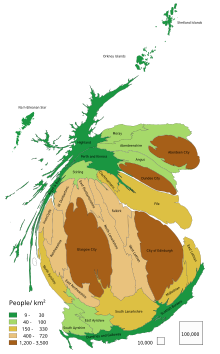
Back سكان إسكتلندا Arabic Skotlannin väestö Finnish Démographie de l'Écosse French Škotijos demografija Lithuanian Demografia da Escócia Portuguese Demografia Scoției Romanian Население Шотландии Russian Demografie o Scotland SCO Demografia e Skocisë Albanian 蘇格蘭人口 Chinese
This article contains too many charts, tables, or data. (November 2022) |
| Demographics of Scotland | |
|---|---|
 Population pyramid of Scotland in 2020 | |
| Population | 5,463,300 (2019) |



| Year | Pop. | ±% |
|---|---|---|
| 1801 | 1,608,420 | — |
| 1811 | 1,805,864 | +12.3% |
| 1821 | 2,091,521 | +15.8% |
| 1831 | 2,364,386 | +13.0% |
| 1841 | 2,620,841 | +10.8% |
| 1851 | 2,888,742 | +10.2% |
| 1861 | 3,062,269 | +6.0% |
| 1871 | 3,360,018 | +9.7% |
| 1881 | 3,735,573 | +11.2% |
| 1891 | 4,033,103 | +8.0% |
| 1901 | 4,472,103 | +10.9% |
| 1911 | 4,760,904 | +6.5% |
| 1921 | 4,888,407 | +2.7% |
| 1931 | 4,842,989 | −0.9% |
| 1951 | 5,095,969 | +5.2% |
| 1961 | 5,179,000 | +1.6% |
| 1971 | 5,229,000 | +1.0% |
| 1981 | 5,035,000 | −3.7% |
| 1991 | 5,083,000 | +1.0% |
| 2001 | 5,062,011 | −0.4% |
| 2011 | 5,295,403 | +4.6% |
| 2022 | 5,436,600 | +2.7% |
| Source:[1][2] | ||
The demography of Scotland includes all aspects of population, past and present, in the area that is now Scotland. Scotland had a population of 5,463,300 in 2019. The population growth rate in 2011 was estimated as 0.6% per annum according to the 2011 GROS Annual Review.[3]
Covering an area of 78,782 square kilometres (30,418 sq mi), Scotland has a population density of 67.2/km2 (174/sq mi). Around 70% of the country's population (3.5 million) live in the Central Belt —a region stretching in a northeast–southwest orientation between the major Scottish cities of Edinburgh and Glasgow, and including the major settlements of Paisley, Stirling, Falkirk, Perth and Dundee, in the Central Lowlands (80%). Other concentrations of population include the northeast coast of Scotland, principally the regions around the cities of Aberdeen and Inverness, and the west coast around the town of Ayr. The Scottish Highlands and the island group of Eilean Siar have the lowest population densities at 9/km2 (23/sq mi). Glasgow has the highest population density at 3,289/km2 (8,520/sq mi).[4]
Until April 2011, responsibility for estimating the population of Scotland, as well as recording births, deaths and marriages, was overseen by the General Register Office for Scotland (GROS), headed by the Registrar-General for Scotland. From 1 April 2011 onwards, the GROS merged with the National Archives of Scotland to become the National Records of Scotland. The new organisation is still required under the terms of the Registration of Births, Deaths and Marriages (Scotland) Act 1965, to present a Registrar-General's annual report of demographic trends to Scottish Ministers. (Prior to devolution it was to the Secretary of State for Scotland). In conjunction with the rest of the United Kingdom, the National Records for Scotland is also responsible for conducting a decadal census of population. The most recent one took place in March 2022.[5]

- ^ United Kingdom census (2011). "Table 1 - Census Day population estimates, 1911 - 2011". National Records of Scotland. Retrieved 13 April 2021.
- ^ "Census Records 1841 to 1911". National Records of Scotland. 31 May 2013. Retrieved 20 February 2018.
- ^ The Registrar General’s Annual Review of Demographic Trends 157th Edition 2011 Archived 2013-06-05 at the Wayback Machine, Accessed 10 February 2013
- ^ United Kingdom census (2011). "Table 2 - Census Day population estimates by age, 1911 - 2011". National Records of Scotland. Retrieved 13 April 2021.
- ^ "National Records of Scotland", Scottish Government news release, archived from the original on 19 August 2014, retrieved 10 February 2013